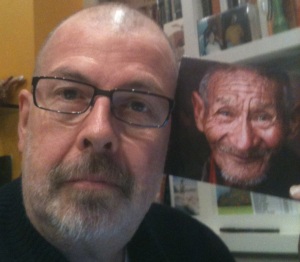
It's not Kojak, really. Hmm, what is it then, I wonder? My eyeglasses make the transition quite well, I think.
After my release from the hospital on Tuesday, following my successful autologous stem cell transplant, I nose-dived into the warmth of my own beloved bed where I slept the sleep of hibernating grizzly bears for nearly two days.
The swelling in my feet from three weeks of IV hydration did not disappear overnight as I had hoped. I instead was hobbled by acute nerve pain in my right foot. You know that nerve, I think. It runs from your big toe, up your instep, past your ankle and up your leg. I could barely walk as a result of the pain radiating from this rediscovered nerve. The very idea of wiggling my big toe sent waves of discomfort straight up my leg. I survived by sleeping and taking pain killers while very carefully using pillows to elevate my leg above my heart to promote drainage in the swollen tissue resting on the top of my right foot.
On Friday, I could walk well enough to report to the doctor’s office for a new CBC (blood) test and any treatment or advice that might follow. It was a pleasure to see the old gang in the Cyrus and Myrtle Katzen Cancer Research Center. There were some new faces but I knew most of the nurses from my months of chemotherapy in 2009. I even received several compliments on my new hair-free look. “Crafty,” one nurse said. That was my favorite.
The CBC returned untroubling, predictable results. My platelets remain undesirably low but they are headed slowly up. My red blood cells are inching up, also, but are still in the asymptomatic anemia range. My white blood cells are proliferating very well. We likely owe the excellent white blood cell numbers to daily shots of Neupogen.
Dr. Tabbara recommended that I walk more, not less, on my afflicted foot. He suggested that the pain was a kind of aftershock to three weeks in bed with minimal daily exercise. He was right. By today, the pain index is down to an acceptably low ache (a 2 or 3). I slept last night without pain medication.
Today also marked my first venture out as wheel man for Ted on our routine Saturday run to the laundry and liquor store. These shops are located a few doors apart on Pennsylvania Avenue, Southeast. There is never a parking space and the police regularly patrol and ticket double parkers. I was able to negotiate the snow clogged streets with aplomb. Noting with nimble profanities that our own carefully dug out space had been taken while we were gone for those 15-20 minutes, we parked in another dug-out space available in our block. If you can’t lick ’em, join ’em, I guess.
The etiquette of reserved dug-out parking spaces (afforded to those who perform the back-breaking task of digging out during snow emergencies) is not well known in our neighborhood. It is unlikely that the etiquette is known or shared widely anywhere in Washington. I understand the etiquette because Ted and I once lived in Somerville, Massachusetts. Entertaining the idea of pirating another person’s carefully dug out spot in Somerville is the same as comtemplating a request for summary execution by snow shovel. That was the community standard where we lived on Summer Hill. I shudder to think what standard they enforced over on Winter Hill, a much tougher section of Somerville. Here on Capitol Hill, the standard seems to be, “Dig out your own space but when you venture out and then return, you may take an available space from some other guy who carefully dug his own.”
After my doctor’s appointment on Friday, we headed to Annapolis to attend the funeral of Dorothy Kraus, our friend Kathy Sitte’s mother. The simple Jewish service was held at the cemetery. The chapel where we gathered was colder than the sunny open air that afternoon.
Here was a woman who lived 91 years and only gave up driving about a month before she died. She had volunteered for years, into and well beyond traditional retirement age, visiting hospitals to bring comfort and assistance to women who were the victims of rape and domestic violence.
May I tell you about the beauty of a simple pine box? It fills me with comfort to imagine my remains carried into the earth in such a box, dissolving without fanfare, like a lozenge, into the earthly matter that is the stuff of our material creation. I’m doing everything in my power to put off that dissolution but the simple pine box remains a lofty ideal, though still too distant to be practical, too superficial to be frightening.
The funeral buffet was wondrous and copious. There was every kind of bagel with every kind of trimming, assorted fish pastes, pastas, noodle dishes, breads, cakes, cookies, and a proud grandson manning the bar. I ate so much it wore me out. Maybe this first day back on my feet had as much to do with it. On the other hand, if you really think so, you didn’t go back for seconds on the kugel or the raspberry coffee cake.









